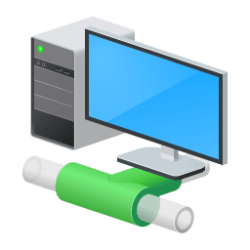This tutorial will show you how to manually create a checkpoint for a Hyper-V virtual machine in Windows 10 and Windows 11.
Hyper-V enables running virtualized computer systems on top of a physical host. These virtualized systems can be used and managed just as if they were physical computer systems, however they exist in virtualized and isolated environment. Special software called a hypervisor manages access between the virtual systems and the physical hardware resources. Virtualization enables quick deployment of computer systems, a way to quickly restore systems to a previously known good state, and the ability to migrate systems between physical hosts.
One of the great benefits to virtualization is the ability to easily save the state of a virtual machine. In Hyper-V this is done through the use of virtual machine checkpoints when enabled. You may want to create a virtual machine checkpoint before making software configuration changes, applying a software update, or installing new software. If a system change were to cause an issue, the virtual machine can be reverted to the state at which it was when then checkpoint was taken.
Hyper-V includes two types of checkpoints:
- Standard Checkpoints: takes a snapshot of the virtual machine and virtual machine memory state at the time the checkpoint is initiated. A snapshot is not a full backup and can cause data consistency issues with systems that replicate data between different nodes such as Active Directory. Hyper-V only offered standard checkpoints (formerly called snapshots) prior to Windows 10.
- Production Checkpoints: uses Volume Shadow Copy Service or File System Freeze on a Linux virtual machine to create a data-consistent backup of the virtual machine. No snapshot of the virtual machine memory state is taken.
When you enable checkpoints for a virtual machine, you can also manually create a checkpoint for the virtual machine on demand as needed.
Reference:

You must be signed in as an administrator to create a checkpoint for a Hyper-V virtual machine.
Contents
- Option One: Create Checkpoint for Hyper-V Virtual Machine in Hyper-V Manager
- Option Two: Create Checkpoint for Hyper-V Virtual Machine in PowerShell
1 Open Hyper-V Manager (virtmgmt.msc).
2 Select the virtual machine (ex: "Windows 11 Home") in the middle pane you want to create a checkpoint for. (see screenshot below)
3 Perform one of the following actions below to create the checkpoint:
- Click/tap on Checkpoint in the right "Actions" pane.
- Click/tap on Action on the menu bar, and click/tap on Checkpoint.
- Right click on the virtual machine in the middle pane, and click/tap on Checkpoint.
If you didn't enable checkpoints for a Hyper-V virtual machine, the commands below will fail to create a checkpoint for that virtual machine.
1 Open Windows Terminal (Admin), and select Windows PowerShell.
2 Type the command below you want to use into Windows Terminal (Admin), and press Enter. (see screenshot below)
(Create Checkpoint for Hyper-V Virtual Machine)
Checkpoint-VM -Name "<VM Name>"OR
(Create Checkpoint for All Hyper-V Virtual Machines)
Checkpoint-VM -Name *Substitute <VM Name> in the command above with the actual virtual machine name (ex: "Windows 11 Home") you want to create a checkpoint for.
For example: Checkpoint-VM -Name "Windows 11 Home"
That's it,
Shawn Brink
Related Tutorials
- Enable or Disable Checkpoints for Hyper-V Virtual Machine in Windows 11
- Enable or Disable Automatic Checkpoints for Hyper-V Virtual Machine in Windows 11
- Rename Checkpoint for Hyper-V Virtual Machine in Windows 11
- Restore Checkpoint for Hyper-V Virtual Machine in Windows 11
- Delete Checkpoints for Hyper-V Virtual Machine in Windows 11
- Export Hyper-V Virtual Machine in Windows 11
Last edited:












